Knowledge Assessment: CHCDIS007 Facilitate Empowerment of People
VerifiedAdded on 2023/02/03
|43
|9472
|84
Homework Assignment
AI Summary
This document presents a completed knowledge assessment for the CHCDIS007 unit, focusing on facilitating the empowerment of people with disabilities. The assignment addresses key concepts such as the social and medical models of service, contrasting them and their historical context. It also explores person-centered versus institutionalized models of support, emphasizing their impact on industry practices. The assessment further delves into the social construction of disability, the impact of personal attitudes, and the importance of seeking support from qualified staff. It includes matching exercises to identify different types of disabilities and related conditions with their definitions, alongside practical support practices. Finally, the assignment examines the legal and ethical considerations, including codes of conduct and anti-discrimination, and their influence on the role of care workers in providing support. The document provides comprehensive answers to all questions, demonstrating an understanding of the core principles of disability care.
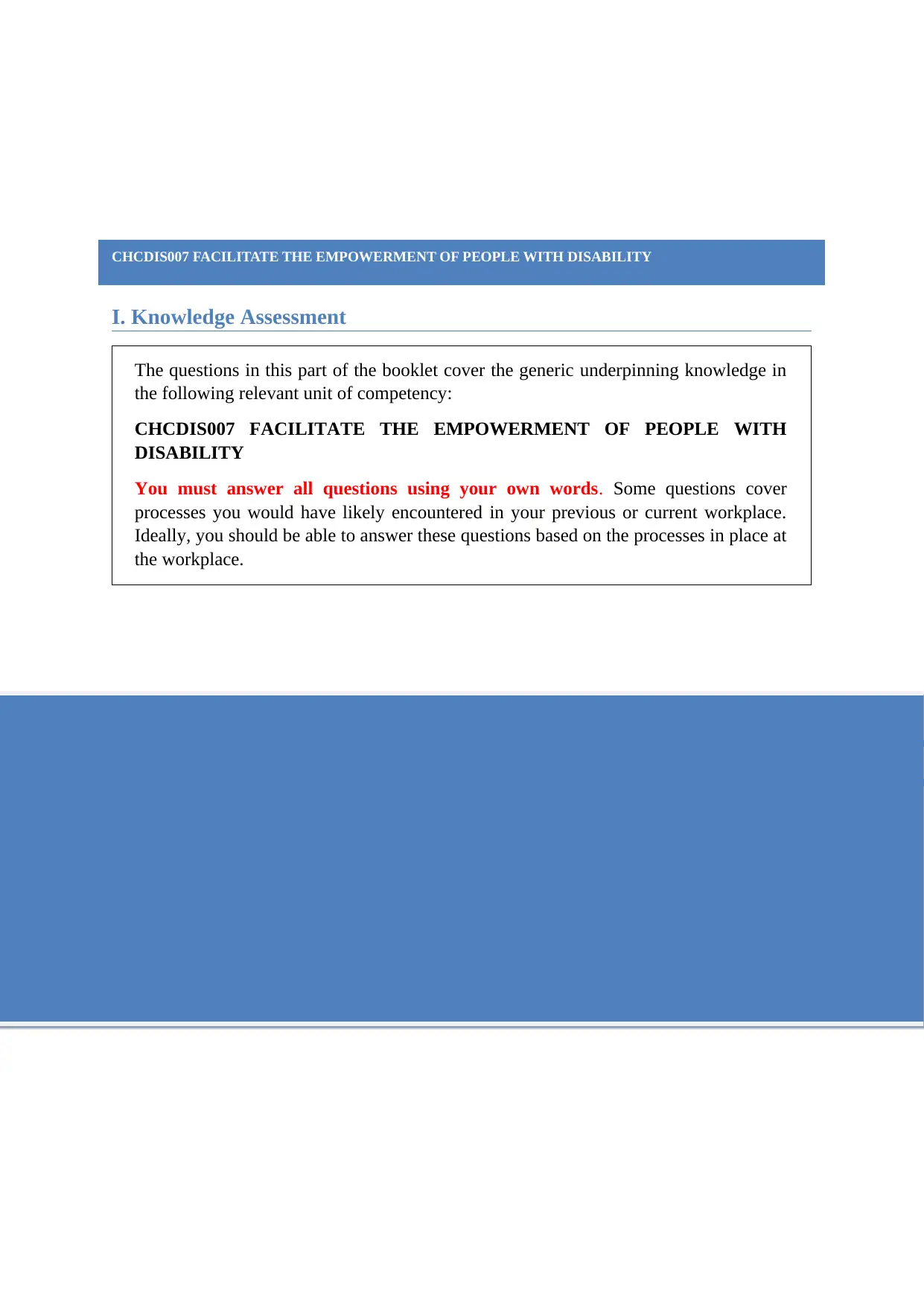
ENT WORKBOOK
CHCDIS007 FACILITATE THE EMPOWERMENT OF PEOPLE WITH DISABILITY
I. Knowledge Assessment
The questions in this part of the booklet cover the generic underpinning knowledge in
the following relevant unit of competency:
CHCDIS007 FACILITATE THE EMPOWERMENT OF PEOPLE WITH
DISABILITY
You must answer all questions using your own words. Some questions cover
processes you would have likely encountered in your previous or current workplace.
Ideally, you should be able to answer these questions based on the processes in place at
the workplace.
CHCDIS007 FACILITATE THE EMPOWERMENT OF PEOPLE WITH DISABILITY
I. Knowledge Assessment
The questions in this part of the booklet cover the generic underpinning knowledge in
the following relevant unit of competency:
CHCDIS007 FACILITATE THE EMPOWERMENT OF PEOPLE WITH
DISABILITY
You must answer all questions using your own words. Some questions cover
processes you would have likely encountered in your previous or current workplace.
Ideally, you should be able to answer these questions based on the processes in place at
the workplace.
Paraphrase This Document
Need a fresh take? Get an instant paraphrase of this document with our AI Paraphraser
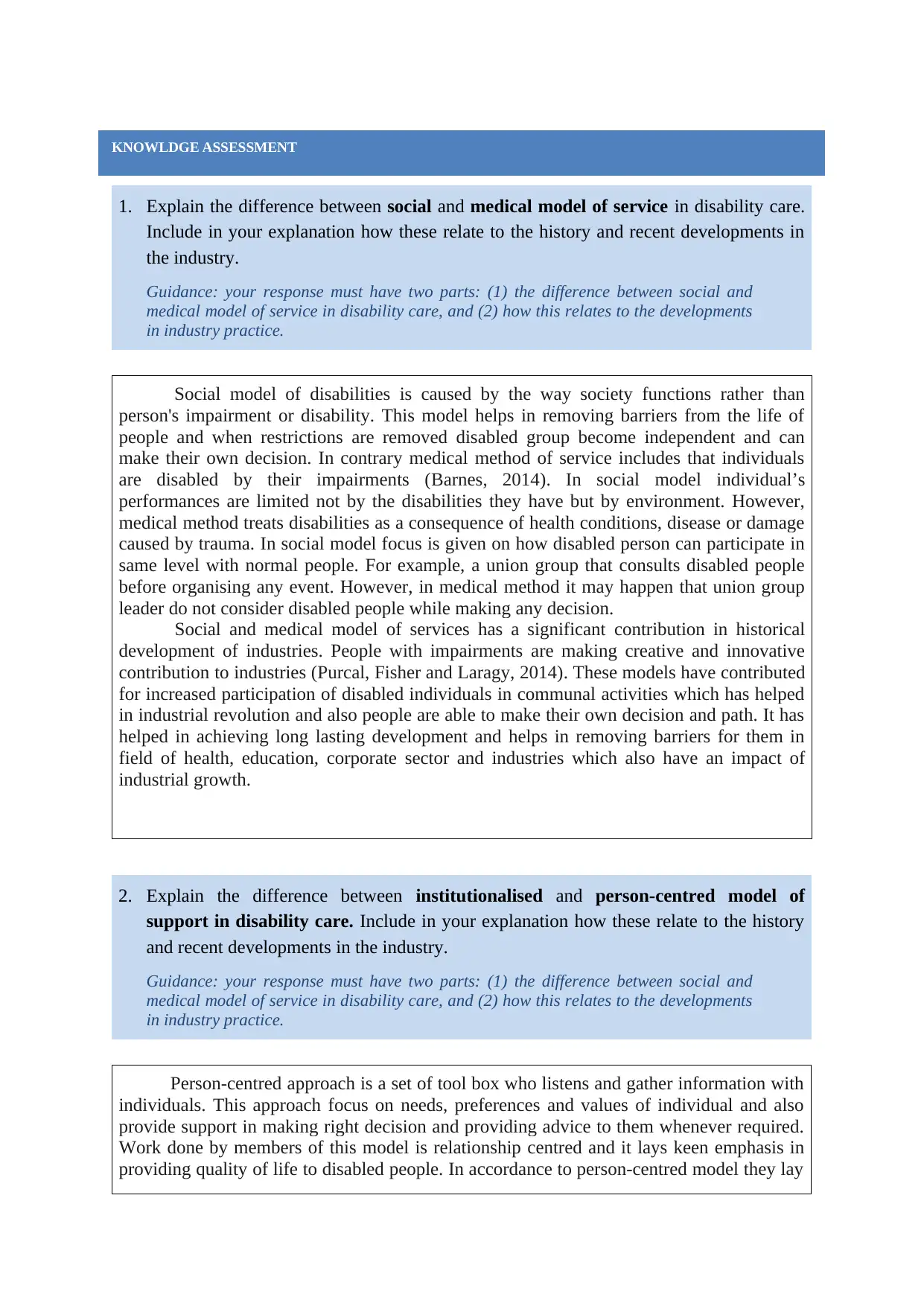
KNOWLDGE ASSESSMENT
1. Explain the difference between social and medical model of service in disability care.
Include in your explanation how these relate to the history and recent developments in
the industry.
Guidance: your response must have two parts: (1) the difference between social and
medical model of service in disability care, and (2) how this relates to the developments
in industry practice.
Social model of disabilities is caused by the way society functions rather than
person's impairment or disability. This model helps in removing barriers from the life of
people and when restrictions are removed disabled group become independent and can
make their own decision. In contrary medical method of service includes that individuals
are disabled by their impairments (Barnes, 2014). In social model individual’s
performances are limited not by the disabilities they have but by environment. However,
medical method treats disabilities as a consequence of health conditions, disease or damage
caused by trauma. In social model focus is given on how disabled person can participate in
same level with normal people. For example, a union group that consults disabled people
before organising any event. However, in medical method it may happen that union group
leader do not consider disabled people while making any decision.
Social and medical model of services has a significant contribution in historical
development of industries. People with impairments are making creative and innovative
contribution to industries (Purcal, Fisher and Laragy, 2014). These models have contributed
for increased participation of disabled individuals in communal activities which has helped
in industrial revolution and also people are able to make their own decision and path. It has
helped in achieving long lasting development and helps in removing barriers for them in
field of health, education, corporate sector and industries which also have an impact of
industrial growth.
2. Explain the difference between institutionalised and person-centred model of
support in disability care. Include in your explanation how these relate to the history
and recent developments in the industry.
Guidance: your response must have two parts: (1) the difference between social and
medical model of service in disability care, and (2) how this relates to the developments
in industry practice.
Person-centred approach is a set of tool box who listens and gather information with
individuals. This approach focus on needs, preferences and values of individual and also
provide support in making right decision and providing advice to them whenever required.
Work done by members of this model is relationship centred and it lays keen emphasis in
providing quality of life to disabled people. In accordance to person-centred model they lay
1. Explain the difference between social and medical model of service in disability care.
Include in your explanation how these relate to the history and recent developments in
the industry.
Guidance: your response must have two parts: (1) the difference between social and
medical model of service in disability care, and (2) how this relates to the developments
in industry practice.
Social model of disabilities is caused by the way society functions rather than
person's impairment or disability. This model helps in removing barriers from the life of
people and when restrictions are removed disabled group become independent and can
make their own decision. In contrary medical method of service includes that individuals
are disabled by their impairments (Barnes, 2014). In social model individual’s
performances are limited not by the disabilities they have but by environment. However,
medical method treats disabilities as a consequence of health conditions, disease or damage
caused by trauma. In social model focus is given on how disabled person can participate in
same level with normal people. For example, a union group that consults disabled people
before organising any event. However, in medical method it may happen that union group
leader do not consider disabled people while making any decision.
Social and medical model of services has a significant contribution in historical
development of industries. People with impairments are making creative and innovative
contribution to industries (Purcal, Fisher and Laragy, 2014). These models have contributed
for increased participation of disabled individuals in communal activities which has helped
in industrial revolution and also people are able to make their own decision and path. It has
helped in achieving long lasting development and helps in removing barriers for them in
field of health, education, corporate sector and industries which also have an impact of
industrial growth.
2. Explain the difference between institutionalised and person-centred model of
support in disability care. Include in your explanation how these relate to the history
and recent developments in the industry.
Guidance: your response must have two parts: (1) the difference between social and
medical model of service in disability care, and (2) how this relates to the developments
in industry practice.
Person-centred approach is a set of tool box who listens and gather information with
individuals. This approach focus on needs, preferences and values of individual and also
provide support in making right decision and providing advice to them whenever required.
Work done by members of this model is relationship centred and it lays keen emphasis in
providing quality of life to disabled people. In accordance to person-centred model they lay
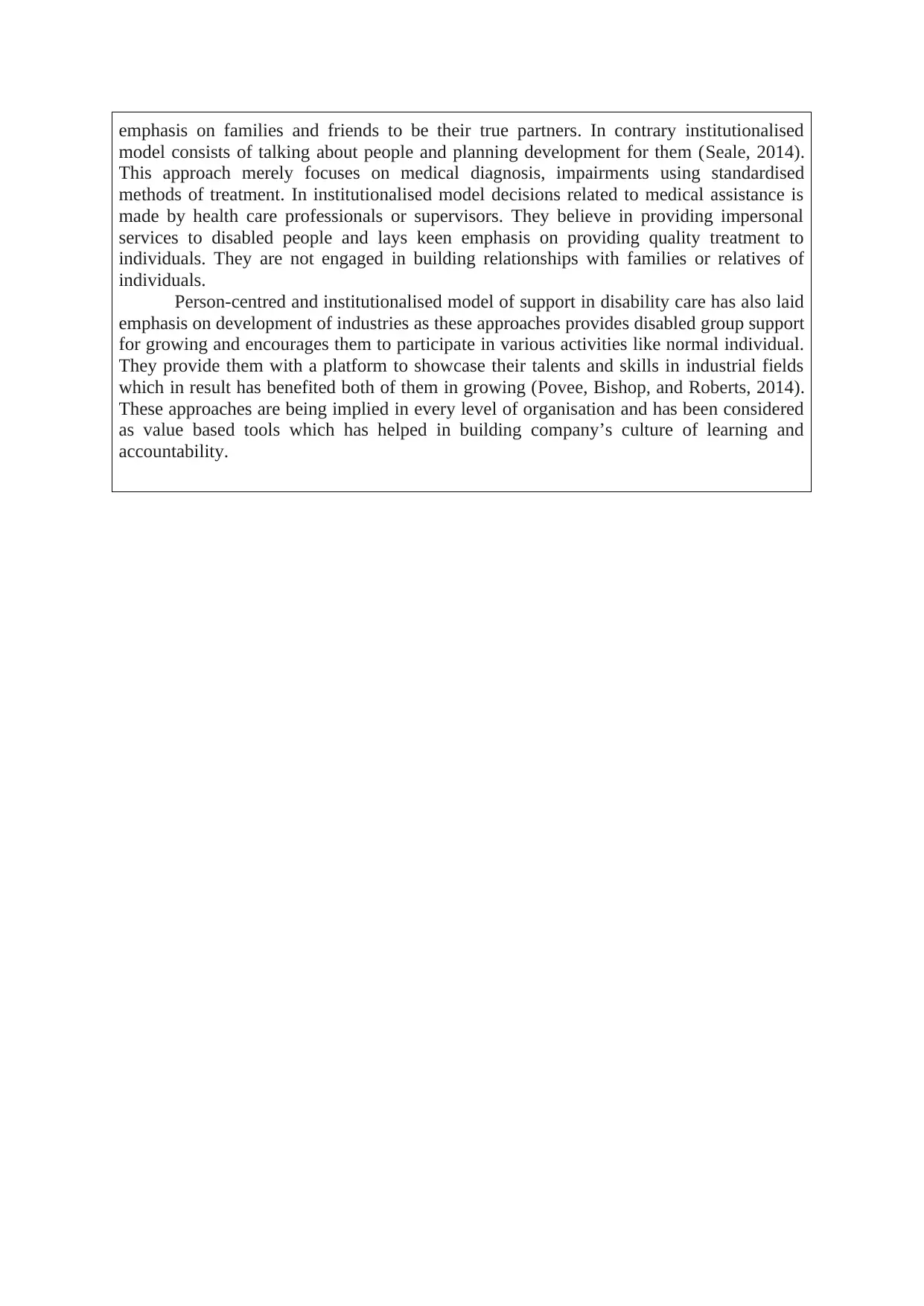
emphasis on families and friends to be their true partners. In contrary institutionalised
model consists of talking about people and planning development for them (Seale, 2014).
This approach merely focuses on medical diagnosis, impairments using standardised
methods of treatment. In institutionalised model decisions related to medical assistance is
made by health care professionals or supervisors. They believe in providing impersonal
services to disabled people and lays keen emphasis on providing quality treatment to
individuals. They are not engaged in building relationships with families or relatives of
individuals.
Person-centred and institutionalised model of support in disability care has also laid
emphasis on development of industries as these approaches provides disabled group support
for growing and encourages them to participate in various activities like normal individual.
They provide them with a platform to showcase their talents and skills in industrial fields
which in result has benefited both of them in growing (Povee, Bishop, and Roberts, 2014).
These approaches are being implied in every level of organisation and has been considered
as value based tools which has helped in building company’s culture of learning and
accountability.
model consists of talking about people and planning development for them (Seale, 2014).
This approach merely focuses on medical diagnosis, impairments using standardised
methods of treatment. In institutionalised model decisions related to medical assistance is
made by health care professionals or supervisors. They believe in providing impersonal
services to disabled people and lays keen emphasis on providing quality treatment to
individuals. They are not engaged in building relationships with families or relatives of
individuals.
Person-centred and institutionalised model of support in disability care has also laid
emphasis on development of industries as these approaches provides disabled group support
for growing and encourages them to participate in various activities like normal individual.
They provide them with a platform to showcase their talents and skills in industrial fields
which in result has benefited both of them in growing (Povee, Bishop, and Roberts, 2014).
These approaches are being implied in every level of organisation and has been considered
as value based tools which has helped in building company’s culture of learning and
accountability.
⊘ This is a preview!⊘
Do you want full access?
Subscribe today to unlock all pages.

Trusted by 1+ million students worldwide
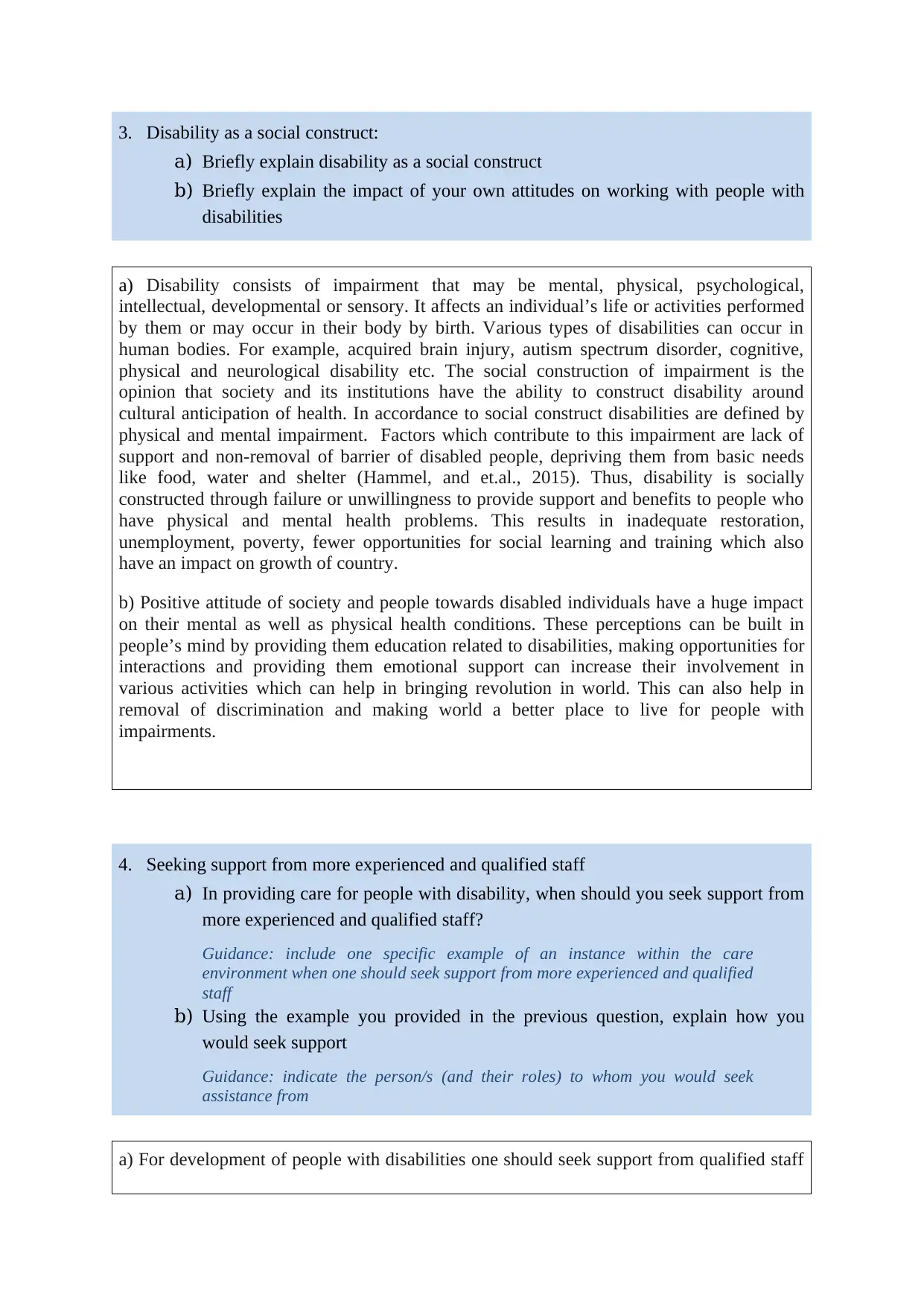
3. Disability as a social construct:
a) Briefly explain disability as a social construct
b) Briefly explain the impact of your own attitudes on working with people with
disabilities
a) Disability consists of impairment that may be mental, physical, psychological,
intellectual, developmental or sensory. It affects an individual’s life or activities performed
by them or may occur in their body by birth. Various types of disabilities can occur in
human bodies. For example, acquired brain injury, autism spectrum disorder, cognitive,
physical and neurological disability etc. The social construction of impairment is the
opinion that society and its institutions have the ability to construct disability around
cultural anticipation of health. In accordance to social construct disabilities are defined by
physical and mental impairment. Factors which contribute to this impairment are lack of
support and non-removal of barrier of disabled people, depriving them from basic needs
like food, water and shelter (Hammel, and et.al., 2015). Thus, disability is socially
constructed through failure or unwillingness to provide support and benefits to people who
have physical and mental health problems. This results in inadequate restoration,
unemployment, poverty, fewer opportunities for social learning and training which also
have an impact on growth of country.
b) Positive attitude of society and people towards disabled individuals have a huge impact
on their mental as well as physical health conditions. These perceptions can be built in
people’s mind by providing them education related to disabilities, making opportunities for
interactions and providing them emotional support can increase their involvement in
various activities which can help in bringing revolution in world. This can also help in
removal of discrimination and making world a better place to live for people with
impairments.
4. Seeking support from more experienced and qualified staff
a) In providing care for people with disability, when should you seek support from
more experienced and qualified staff?
Guidance: include one specific example of an instance within the care
environment when one should seek support from more experienced and qualified
staff
b) Using the example you provided in the previous question, explain how you
would seek support
Guidance: indicate the person/s (and their roles) to whom you would seek
assistance from
a) For development of people with disabilities one should seek support from qualified staff
a) Briefly explain disability as a social construct
b) Briefly explain the impact of your own attitudes on working with people with
disabilities
a) Disability consists of impairment that may be mental, physical, psychological,
intellectual, developmental or sensory. It affects an individual’s life or activities performed
by them or may occur in their body by birth. Various types of disabilities can occur in
human bodies. For example, acquired brain injury, autism spectrum disorder, cognitive,
physical and neurological disability etc. The social construction of impairment is the
opinion that society and its institutions have the ability to construct disability around
cultural anticipation of health. In accordance to social construct disabilities are defined by
physical and mental impairment. Factors which contribute to this impairment are lack of
support and non-removal of barrier of disabled people, depriving them from basic needs
like food, water and shelter (Hammel, and et.al., 2015). Thus, disability is socially
constructed through failure or unwillingness to provide support and benefits to people who
have physical and mental health problems. This results in inadequate restoration,
unemployment, poverty, fewer opportunities for social learning and training which also
have an impact on growth of country.
b) Positive attitude of society and people towards disabled individuals have a huge impact
on their mental as well as physical health conditions. These perceptions can be built in
people’s mind by providing them education related to disabilities, making opportunities for
interactions and providing them emotional support can increase their involvement in
various activities which can help in bringing revolution in world. This can also help in
removal of discrimination and making world a better place to live for people with
impairments.
4. Seeking support from more experienced and qualified staff
a) In providing care for people with disability, when should you seek support from
more experienced and qualified staff?
Guidance: include one specific example of an instance within the care
environment when one should seek support from more experienced and qualified
staff
b) Using the example you provided in the previous question, explain how you
would seek support
Guidance: indicate the person/s (and their roles) to whom you would seek
assistance from
a) For development of people with disabilities one should seek support from qualified staff
Paraphrase This Document
Need a fresh take? Get an instant paraphrase of this document with our AI Paraphraser
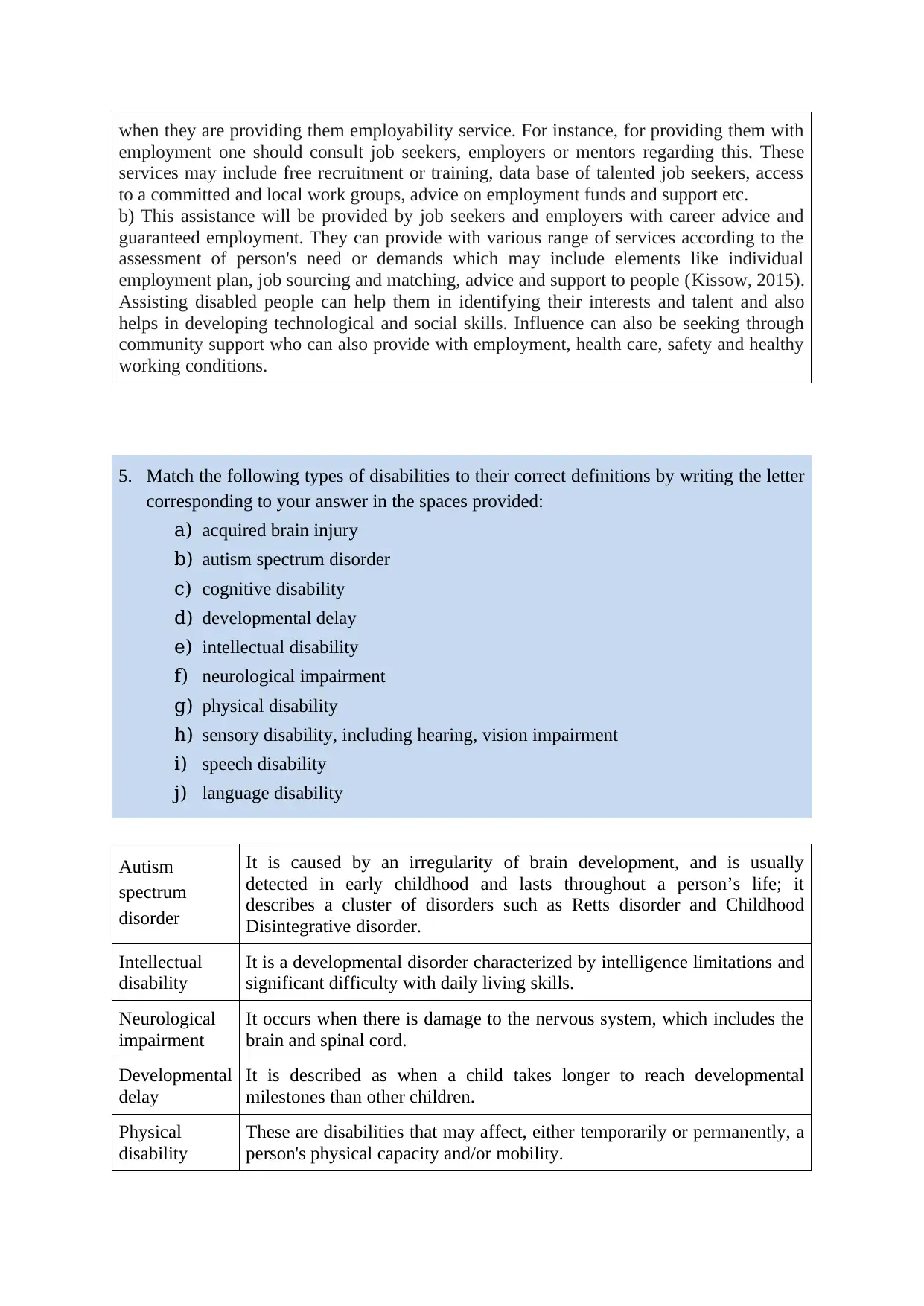
when they are providing them employability service. For instance, for providing them with
employment one should consult job seekers, employers or mentors regarding this. These
services may include free recruitment or training, data base of talented job seekers, access
to a committed and local work groups, advice on employment funds and support etc.
b) This assistance will be provided by job seekers and employers with career advice and
guaranteed employment. They can provide with various range of services according to the
assessment of person's need or demands which may include elements like individual
employment plan, job sourcing and matching, advice and support to people (Kissow, 2015).
Assisting disabled people can help them in identifying their interests and talent and also
helps in developing technological and social skills. Influence can also be seeking through
community support who can also provide with employment, health care, safety and healthy
working conditions.
5. Match the following types of disabilities to their correct definitions by writing the letter
corresponding to your answer in the spaces provided:
a) acquired brain injury
b) autism spectrum disorder
c) cognitive disability
d) developmental delay
e) intellectual disability
f) neurological impairment
g) physical disability
h) sensory disability, including hearing, vision impairment
i) speech disability
j) language disability
Autism
spectrum
disorder
It is caused by an irregularity of brain development, and is usually
detected in early childhood and lasts throughout a person’s life; it
describes a cluster of disorders such as Retts disorder and Childhood
Disintegrative disorder.
Intellectual
disability
It is a developmental disorder characterized by intelligence limitations and
significant difficulty with daily living skills.
Neurological
impairment
It occurs when there is damage to the nervous system, which includes the
brain and spinal cord.
Developmental
delay
It is described as when a child takes longer to reach developmental
milestones than other children.
Physical
disability
These are disabilities that may affect, either temporarily or permanently, a
person's physical capacity and/or mobility.
employment one should consult job seekers, employers or mentors regarding this. These
services may include free recruitment or training, data base of talented job seekers, access
to a committed and local work groups, advice on employment funds and support etc.
b) This assistance will be provided by job seekers and employers with career advice and
guaranteed employment. They can provide with various range of services according to the
assessment of person's need or demands which may include elements like individual
employment plan, job sourcing and matching, advice and support to people (Kissow, 2015).
Assisting disabled people can help them in identifying their interests and talent and also
helps in developing technological and social skills. Influence can also be seeking through
community support who can also provide with employment, health care, safety and healthy
working conditions.
5. Match the following types of disabilities to their correct definitions by writing the letter
corresponding to your answer in the spaces provided:
a) acquired brain injury
b) autism spectrum disorder
c) cognitive disability
d) developmental delay
e) intellectual disability
f) neurological impairment
g) physical disability
h) sensory disability, including hearing, vision impairment
i) speech disability
j) language disability
Autism
spectrum
disorder
It is caused by an irregularity of brain development, and is usually
detected in early childhood and lasts throughout a person’s life; it
describes a cluster of disorders such as Retts disorder and Childhood
Disintegrative disorder.
Intellectual
disability
It is a developmental disorder characterized by intelligence limitations and
significant difficulty with daily living skills.
Neurological
impairment
It occurs when there is damage to the nervous system, which includes the
brain and spinal cord.
Developmental
delay
It is described as when a child takes longer to reach developmental
milestones than other children.
Physical
disability
These are disabilities that may affect, either temporarily or permanently, a
person's physical capacity and/or mobility.
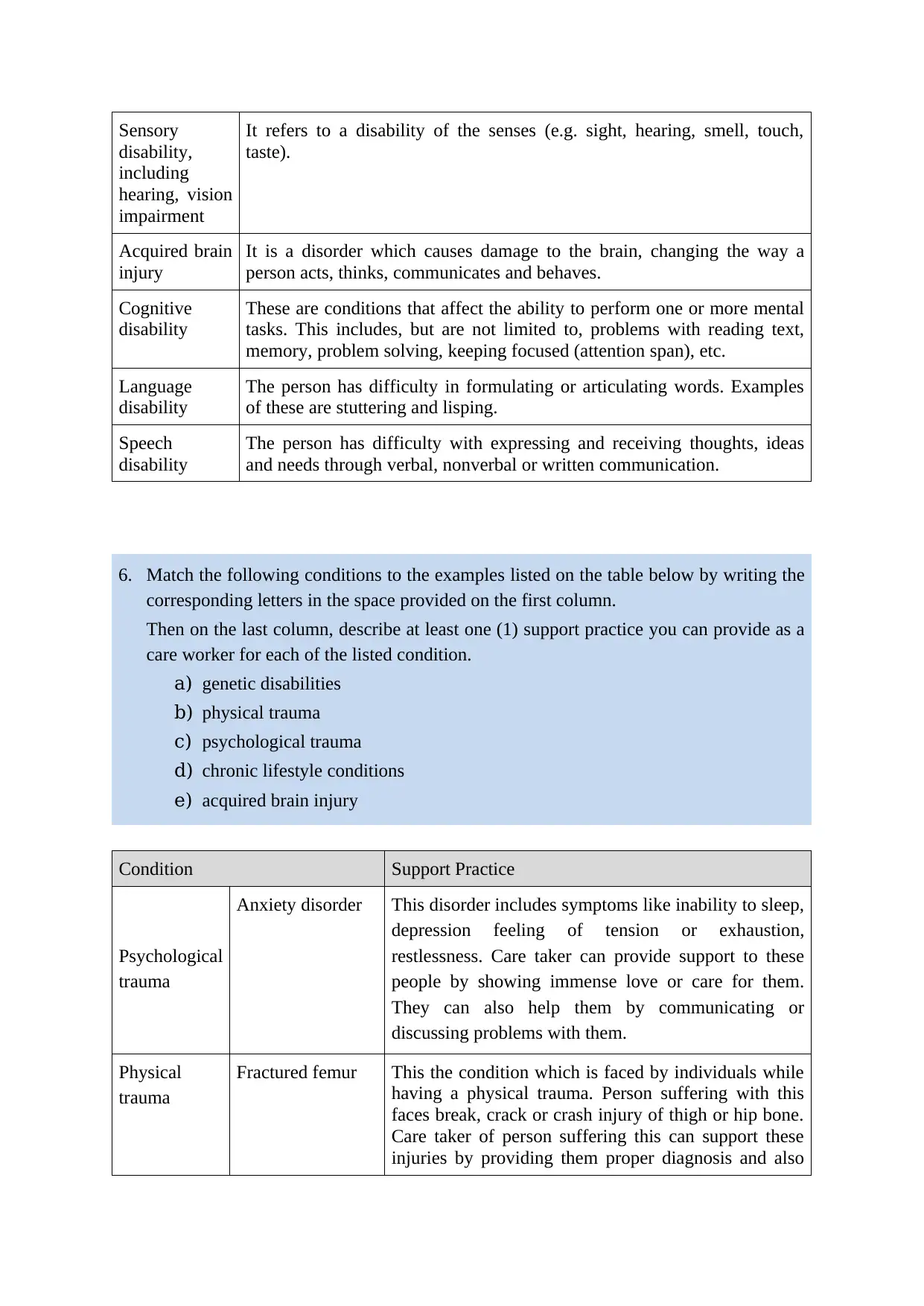
Sensory
disability,
including
hearing, vision
impairment
It refers to a disability of the senses (e.g. sight, hearing, smell, touch,
taste).
Acquired brain
injury
It is a disorder which causes damage to the brain, changing the way a
person acts, thinks, communicates and behaves.
Cognitive
disability
These are conditions that affect the ability to perform one or more mental
tasks. This includes, but are not limited to, problems with reading text,
memory, problem solving, keeping focused (attention span), etc.
Language
disability
The person has difficulty in formulating or articulating words. Examples
of these are stuttering and lisping.
Speech
disability
The person has difficulty with expressing and receiving thoughts, ideas
and needs through verbal, nonverbal or written communication.
6. Match the following conditions to the examples listed on the table below by writing the
corresponding letters in the space provided on the first column.
Then on the last column, describe at least one (1) support practice you can provide as a
care worker for each of the listed condition.
a) genetic disabilities
b) physical trauma
c) psychological trauma
d) chronic lifestyle conditions
e) acquired brain injury
Condition Support Practice
Psychological
trauma
Anxiety disorder This disorder includes symptoms like inability to sleep,
depression feeling of tension or exhaustion,
restlessness. Care taker can provide support to these
people by showing immense love or care for them.
They can also help them by communicating or
discussing problems with them.
Physical
trauma
Fractured femur This the condition which is faced by individuals while
having a physical trauma. Person suffering with this
faces break, crack or crash injury of thigh or hip bone.
Care taker of person suffering this can support these
injuries by providing them proper diagnosis and also
disability,
including
hearing, vision
impairment
It refers to a disability of the senses (e.g. sight, hearing, smell, touch,
taste).
Acquired brain
injury
It is a disorder which causes damage to the brain, changing the way a
person acts, thinks, communicates and behaves.
Cognitive
disability
These are conditions that affect the ability to perform one or more mental
tasks. This includes, but are not limited to, problems with reading text,
memory, problem solving, keeping focused (attention span), etc.
Language
disability
The person has difficulty in formulating or articulating words. Examples
of these are stuttering and lisping.
Speech
disability
The person has difficulty with expressing and receiving thoughts, ideas
and needs through verbal, nonverbal or written communication.
6. Match the following conditions to the examples listed on the table below by writing the
corresponding letters in the space provided on the first column.
Then on the last column, describe at least one (1) support practice you can provide as a
care worker for each of the listed condition.
a) genetic disabilities
b) physical trauma
c) psychological trauma
d) chronic lifestyle conditions
e) acquired brain injury
Condition Support Practice
Psychological
trauma
Anxiety disorder This disorder includes symptoms like inability to sleep,
depression feeling of tension or exhaustion,
restlessness. Care taker can provide support to these
people by showing immense love or care for them.
They can also help them by communicating or
discussing problems with them.
Physical
trauma
Fractured femur This the condition which is faced by individuals while
having a physical trauma. Person suffering with this
faces break, crack or crash injury of thigh or hip bone.
Care taker of person suffering this can support these
injuries by providing them proper diagnosis and also
⊘ This is a preview!⊘
Do you want full access?
Subscribe today to unlock all pages.

Trusted by 1+ million students worldwide
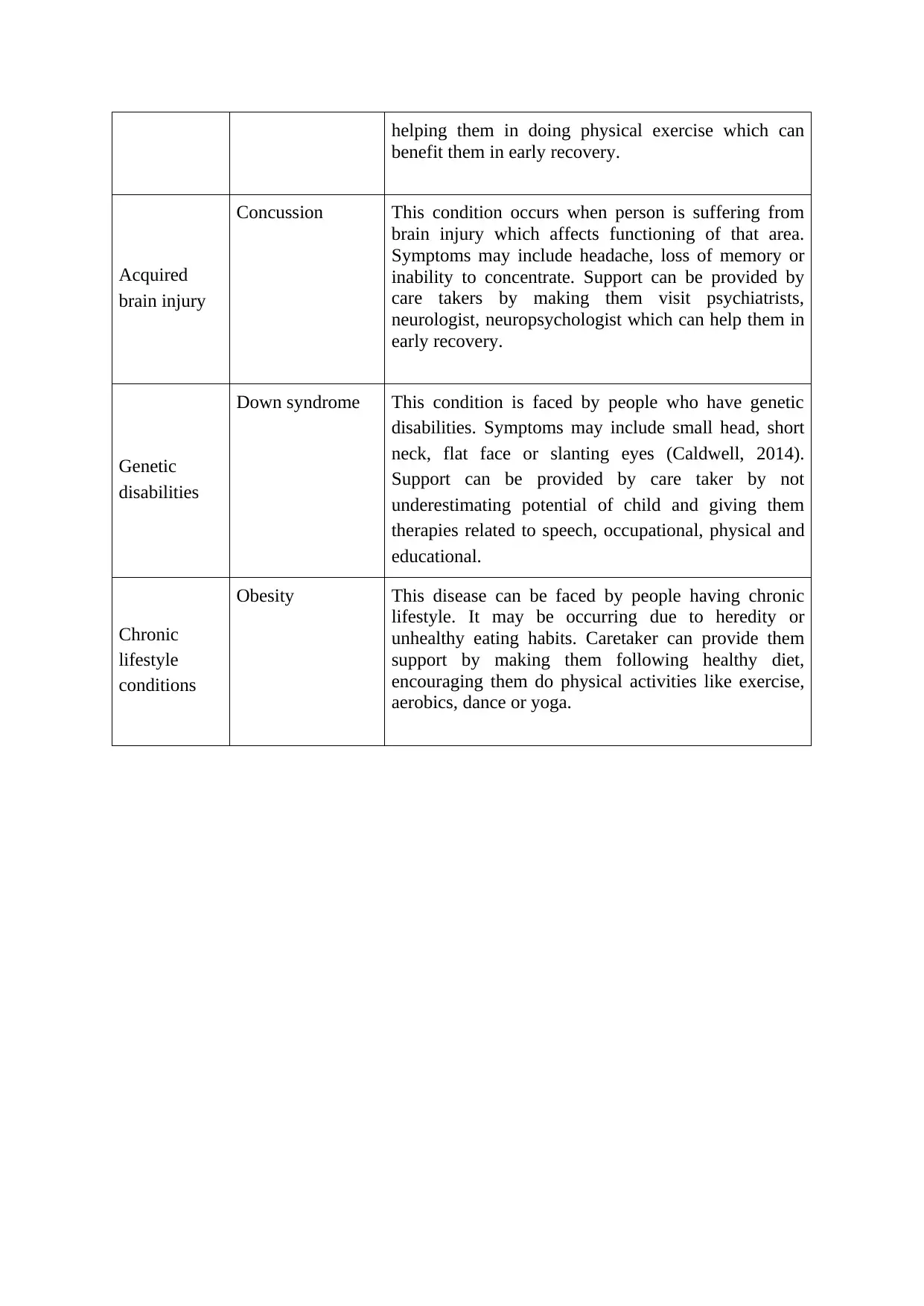
helping them in doing physical exercise which can
benefit them in early recovery.
Acquired
brain injury
Concussion This condition occurs when person is suffering from
brain injury which affects functioning of that area.
Symptoms may include headache, loss of memory or
inability to concentrate. Support can be provided by
care takers by making them visit psychiatrists,
neurologist, neuropsychologist which can help them in
early recovery.
Genetic
disabilities
Down syndrome This condition is faced by people who have genetic
disabilities. Symptoms may include small head, short
neck, flat face or slanting eyes (Caldwell, 2014).
Support can be provided by care taker by not
underestimating potential of child and giving them
therapies related to speech, occupational, physical and
educational.
Chronic
lifestyle
conditions
Obesity This disease can be faced by people having chronic
lifestyle. It may be occurring due to heredity or
unhealthy eating habits. Caretaker can provide them
support by making them following healthy diet,
encouraging them do physical activities like exercise,
aerobics, dance or yoga.
benefit them in early recovery.
Acquired
brain injury
Concussion This condition occurs when person is suffering from
brain injury which affects functioning of that area.
Symptoms may include headache, loss of memory or
inability to concentrate. Support can be provided by
care takers by making them visit psychiatrists,
neurologist, neuropsychologist which can help them in
early recovery.
Genetic
disabilities
Down syndrome This condition is faced by people who have genetic
disabilities. Symptoms may include small head, short
neck, flat face or slanting eyes (Caldwell, 2014).
Support can be provided by care taker by not
underestimating potential of child and giving them
therapies related to speech, occupational, physical and
educational.
Chronic
lifestyle
conditions
Obesity This disease can be faced by people having chronic
lifestyle. It may be occurring due to heredity or
unhealthy eating habits. Caretaker can provide them
support by making them following healthy diet,
encouraging them do physical activities like exercise,
aerobics, dance or yoga.
Paraphrase This Document
Need a fresh take? Get an instant paraphrase of this document with our AI Paraphraser
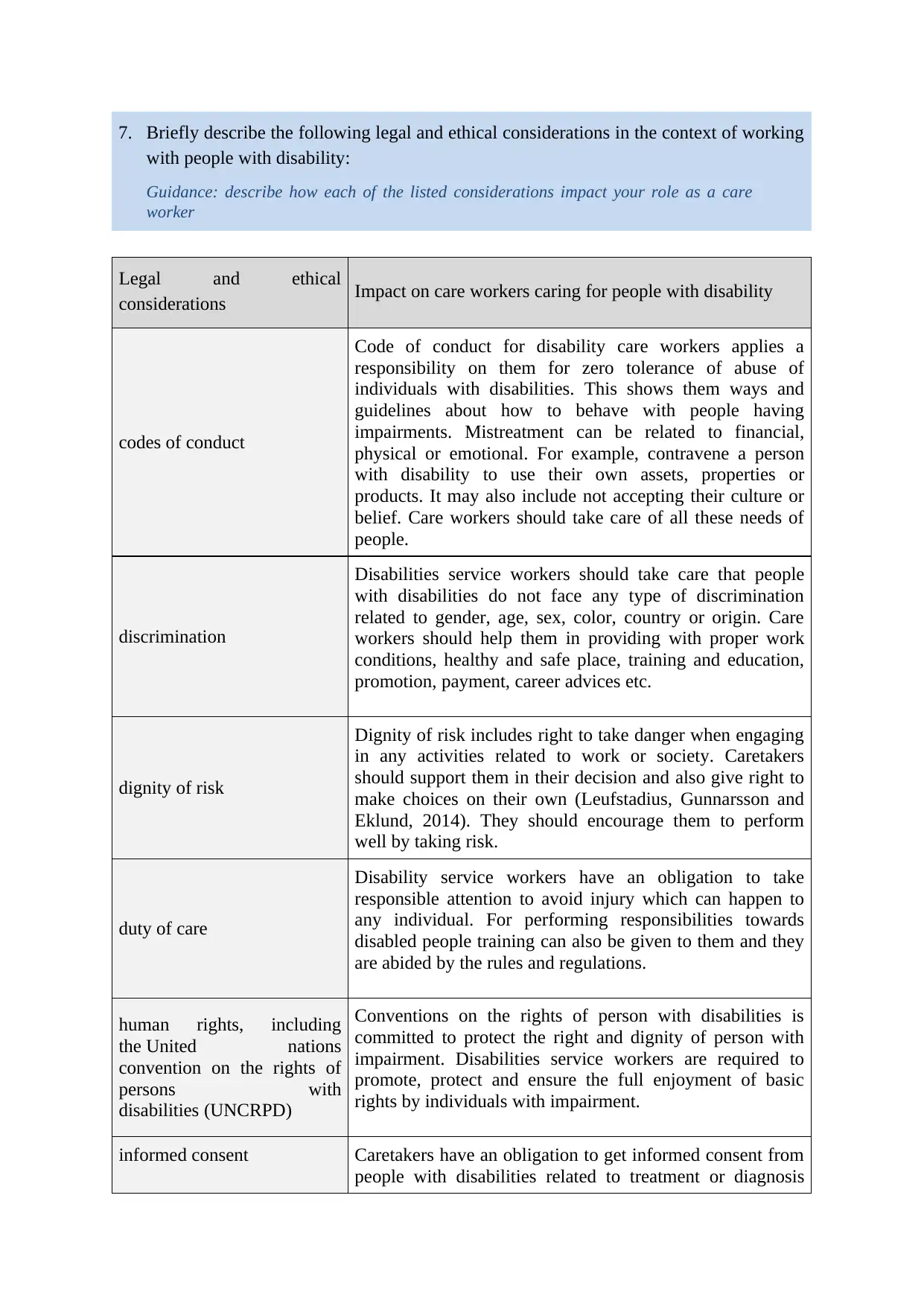
7. Briefly describe the following legal and ethical considerations in the context of working
with people with disability:
Guidance: describe how each of the listed considerations impact your role as a care
worker
Legal and ethical
considerations Impact on care workers caring for people with disability
codes of conduct
Code of conduct for disability care workers applies a
responsibility on them for zero tolerance of abuse of
individuals with disabilities. This shows them ways and
guidelines about how to behave with people having
impairments. Mistreatment can be related to financial,
physical or emotional. For example, contravene a person
with disability to use their own assets, properties or
products. It may also include not accepting their culture or
belief. Care workers should take care of all these needs of
people.
discrimination
Disabilities service workers should take care that people
with disabilities do not face any type of discrimination
related to gender, age, sex, color, country or origin. Care
workers should help them in providing with proper work
conditions, healthy and safe place, training and education,
promotion, payment, career advices etc.
dignity of risk
Dignity of risk includes right to take danger when engaging
in any activities related to work or society. Caretakers
should support them in their decision and also give right to
make choices on their own (Leufstadius, Gunnarsson and
Eklund, 2014). They should encourage them to perform
well by taking risk.
duty of care
Disability service workers have an obligation to take
responsible attention to avoid injury which can happen to
any individual. For performing responsibilities towards
disabled people training can also be given to them and they
are abided by the rules and regulations.
human rights, including
the United nations
convention on the rights of
persons with
disabilities (UNCRPD)
Conventions on the rights of person with disabilities is
committed to protect the right and dignity of person with
impairment. Disabilities service workers are required to
promote, protect and ensure the full enjoyment of basic
rights by individuals with impairment.
informed consent Caretakers have an obligation to get informed consent from
people with disabilities related to treatment or diagnosis
with people with disability:
Guidance: describe how each of the listed considerations impact your role as a care
worker
Legal and ethical
considerations Impact on care workers caring for people with disability
codes of conduct
Code of conduct for disability care workers applies a
responsibility on them for zero tolerance of abuse of
individuals with disabilities. This shows them ways and
guidelines about how to behave with people having
impairments. Mistreatment can be related to financial,
physical or emotional. For example, contravene a person
with disability to use their own assets, properties or
products. It may also include not accepting their culture or
belief. Care workers should take care of all these needs of
people.
discrimination
Disabilities service workers should take care that people
with disabilities do not face any type of discrimination
related to gender, age, sex, color, country or origin. Care
workers should help them in providing with proper work
conditions, healthy and safe place, training and education,
promotion, payment, career advices etc.
dignity of risk
Dignity of risk includes right to take danger when engaging
in any activities related to work or society. Caretakers
should support them in their decision and also give right to
make choices on their own (Leufstadius, Gunnarsson and
Eklund, 2014). They should encourage them to perform
well by taking risk.
duty of care
Disability service workers have an obligation to take
responsible attention to avoid injury which can happen to
any individual. For performing responsibilities towards
disabled people training can also be given to them and they
are abided by the rules and regulations.
human rights, including
the United nations
convention on the rights of
persons with
disabilities (UNCRPD)
Conventions on the rights of person with disabilities is
committed to protect the right and dignity of person with
impairment. Disabilities service workers are required to
promote, protect and ensure the full enjoyment of basic
rights by individuals with impairment.
informed consent Caretakers have an obligation to get informed consent from
people with disabilities related to treatment or diagnosis
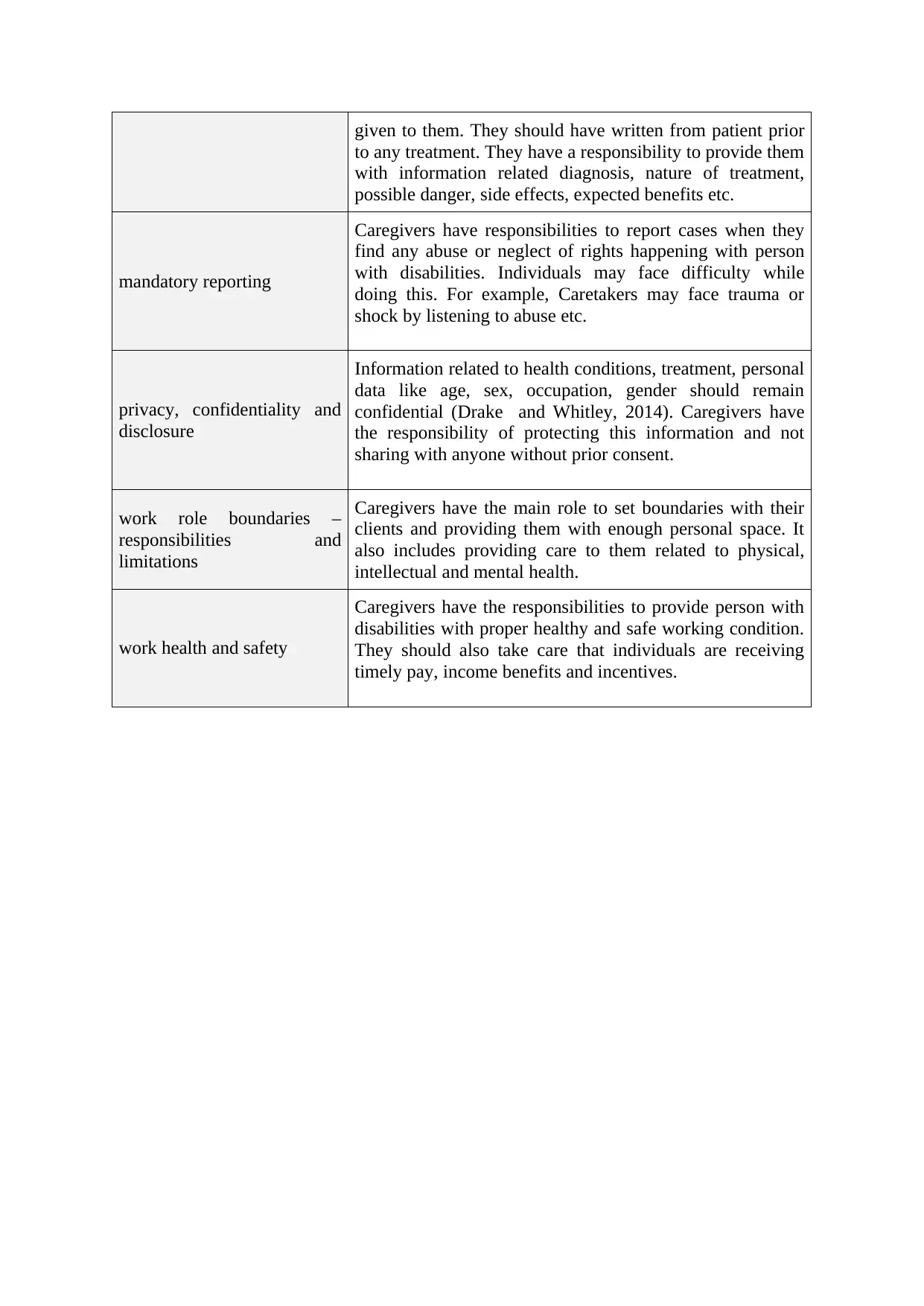
given to them. They should have written from patient prior
to any treatment. They have a responsibility to provide them
with information related diagnosis, nature of treatment,
possible danger, side effects, expected benefits etc.
mandatory reporting
Caregivers have responsibilities to report cases when they
find any abuse or neglect of rights happening with person
with disabilities. Individuals may face difficulty while
doing this. For example, Caretakers may face trauma or
shock by listening to abuse etc.
privacy, confidentiality and
disclosure
Information related to health conditions, treatment, personal
data like age, sex, occupation, gender should remain
confidential (Drake and Whitley, 2014). Caregivers have
the responsibility of protecting this information and not
sharing with anyone without prior consent.
work role boundaries –
responsibilities and
limitations
Caregivers have the main role to set boundaries with their
clients and providing them with enough personal space. It
also includes providing care to them related to physical,
intellectual and mental health.
work health and safety
Caregivers have the responsibilities to provide person with
disabilities with proper healthy and safe working condition.
They should also take care that individuals are receiving
timely pay, income benefits and incentives.
to any treatment. They have a responsibility to provide them
with information related diagnosis, nature of treatment,
possible danger, side effects, expected benefits etc.
mandatory reporting
Caregivers have responsibilities to report cases when they
find any abuse or neglect of rights happening with person
with disabilities. Individuals may face difficulty while
doing this. For example, Caretakers may face trauma or
shock by listening to abuse etc.
privacy, confidentiality and
disclosure
Information related to health conditions, treatment, personal
data like age, sex, occupation, gender should remain
confidential (Drake and Whitley, 2014). Caregivers have
the responsibility of protecting this information and not
sharing with anyone without prior consent.
work role boundaries –
responsibilities and
limitations
Caregivers have the main role to set boundaries with their
clients and providing them with enough personal space. It
also includes providing care to them related to physical,
intellectual and mental health.
work health and safety
Caregivers have the responsibilities to provide person with
disabilities with proper healthy and safe working condition.
They should also take care that individuals are receiving
timely pay, income benefits and incentives.
⊘ This is a preview!⊘
Do you want full access?
Subscribe today to unlock all pages.

Trusted by 1+ million students worldwide
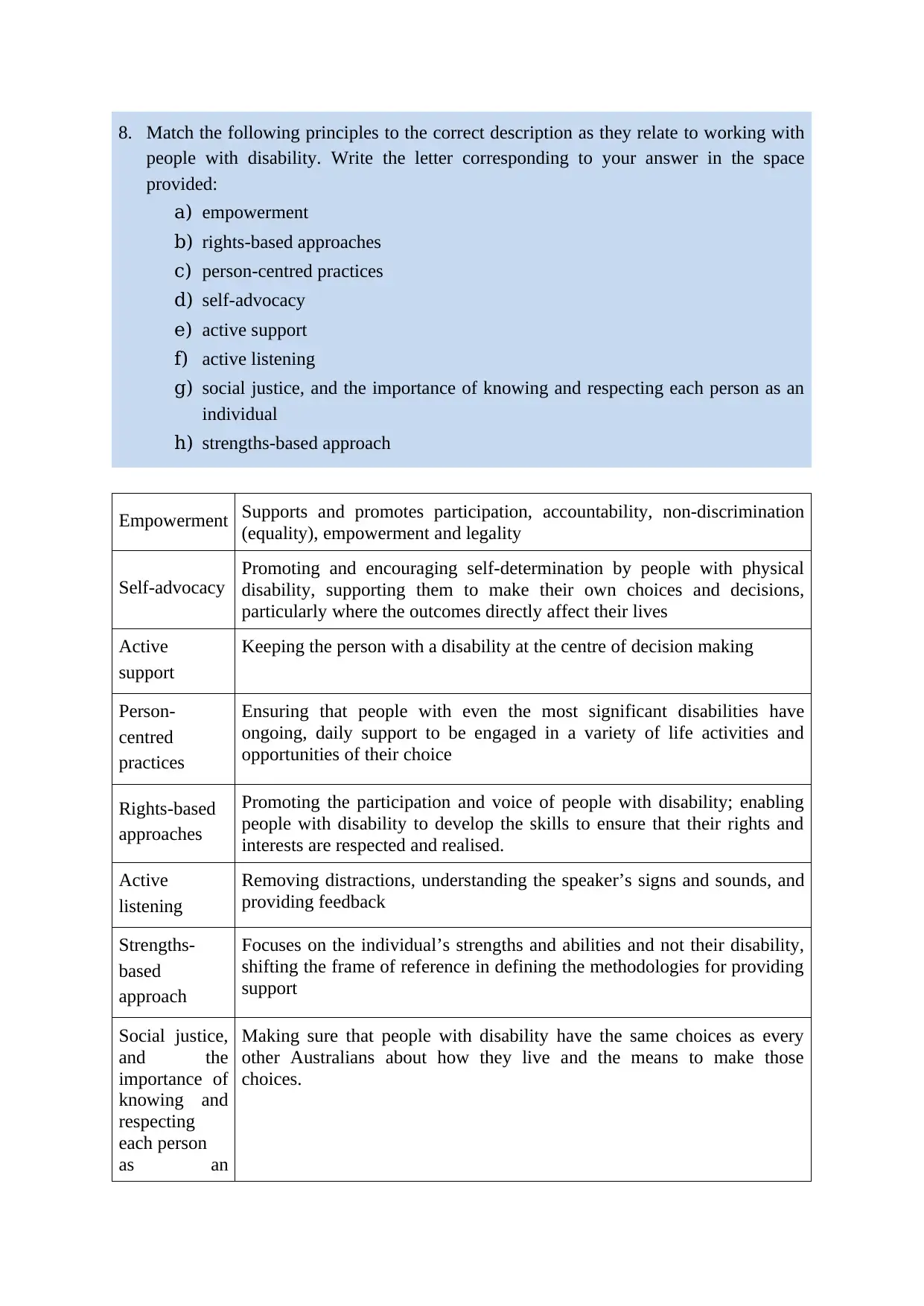
8. Match the following principles to the correct description as they relate to working with
people with disability. Write the letter corresponding to your answer in the space
provided:
a) empowerment
b) rights-based approaches
c) person-centred practices
d) self-advocacy
e) active support
f) active listening
g) social justice, and the importance of knowing and respecting each person as an
individual
h) strengths-based approach
Empowerment Supports and promotes participation, accountability, non-discrimination
(equality), empowerment and legality
Self-advocacy
Promoting and encouraging self-determination by people with physical
disability, supporting them to make their own choices and decisions,
particularly where the outcomes directly affect their lives
Active
support
Keeping the person with a disability at the centre of decision making
Person-
centred
practices
Ensuring that people with even the most significant disabilities have
ongoing, daily support to be engaged in a variety of life activities and
opportunities of their choice
Rights-based
approaches
Promoting the participation and voice of people with disability; enabling
people with disability to develop the skills to ensure that their rights and
interests are respected and realised.
Active
listening
Removing distractions, understanding the speaker’s signs and sounds, and
providing feedback
Strengths-
based
approach
Focuses on the individual’s strengths and abilities and not their disability,
shifting the frame of reference in defining the methodologies for providing
support
Social justice,
and the
importance of
knowing and
respecting
each person
as an
Making sure that people with disability have the same choices as every
other Australians about how they live and the means to make those
choices.
people with disability. Write the letter corresponding to your answer in the space
provided:
a) empowerment
b) rights-based approaches
c) person-centred practices
d) self-advocacy
e) active support
f) active listening
g) social justice, and the importance of knowing and respecting each person as an
individual
h) strengths-based approach
Empowerment Supports and promotes participation, accountability, non-discrimination
(equality), empowerment and legality
Self-advocacy
Promoting and encouraging self-determination by people with physical
disability, supporting them to make their own choices and decisions,
particularly where the outcomes directly affect their lives
Active
support
Keeping the person with a disability at the centre of decision making
Person-
centred
practices
Ensuring that people with even the most significant disabilities have
ongoing, daily support to be engaged in a variety of life activities and
opportunities of their choice
Rights-based
approaches
Promoting the participation and voice of people with disability; enabling
people with disability to develop the skills to ensure that their rights and
interests are respected and realised.
Active
listening
Removing distractions, understanding the speaker’s signs and sounds, and
providing feedback
Strengths-
based
approach
Focuses on the individual’s strengths and abilities and not their disability,
shifting the frame of reference in defining the methodologies for providing
support
Social justice,
and the
importance of
knowing and
respecting
each person
as an
Making sure that people with disability have the same choices as every
other Australians about how they live and the means to make those
choices.
Paraphrase This Document
Need a fresh take? Get an instant paraphrase of this document with our AI Paraphraser

individual
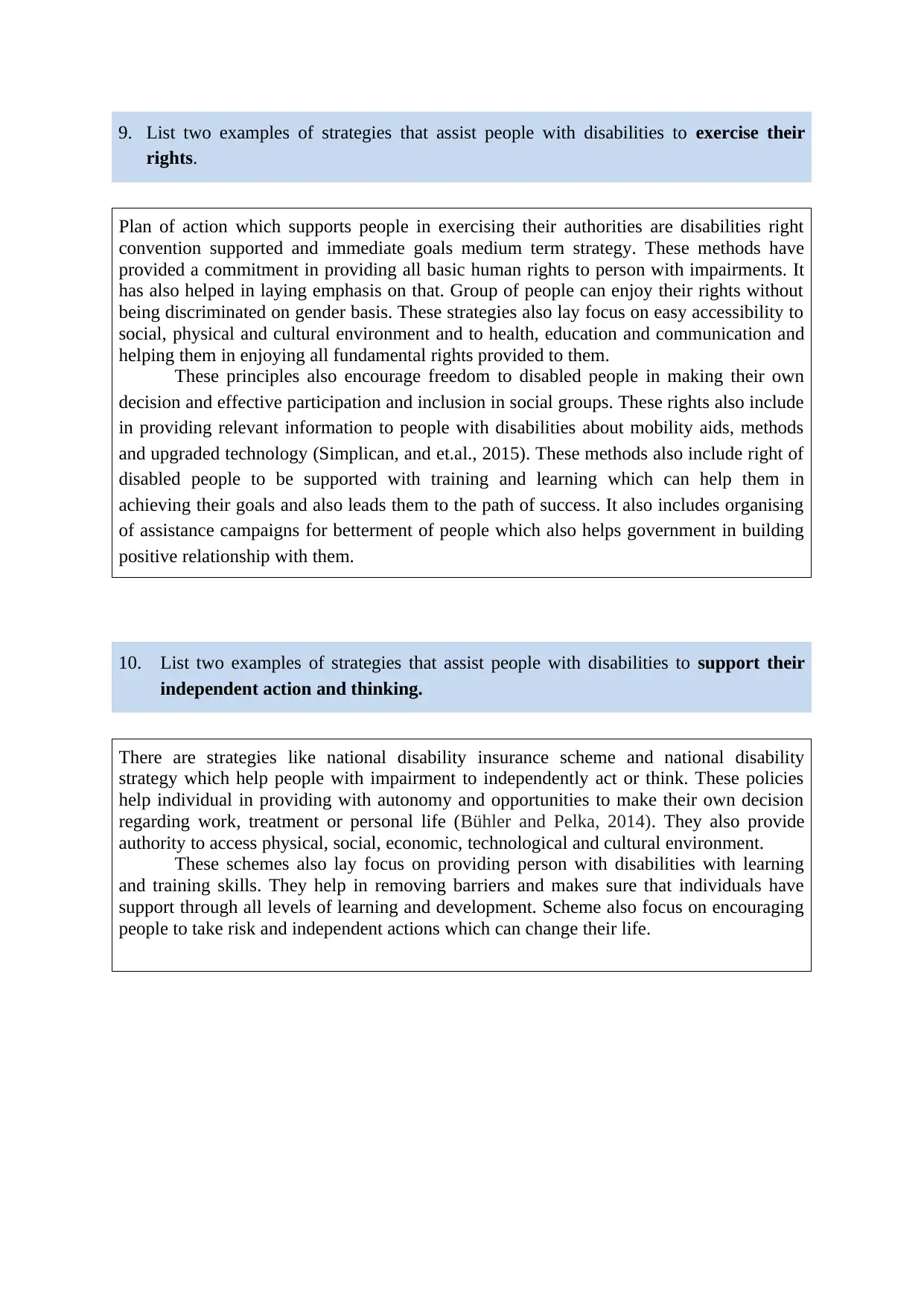
9. List two examples of strategies that assist people with disabilities to exercise their
rights.
Plan of action which supports people in exercising their authorities are disabilities right
convention supported and immediate goals medium term strategy. These methods have
provided a commitment in providing all basic human rights to person with impairments. It
has also helped in laying emphasis on that. Group of people can enjoy their rights without
being discriminated on gender basis. These strategies also lay focus on easy accessibility to
social, physical and cultural environment and to health, education and communication and
helping them in enjoying all fundamental rights provided to them.
These principles also encourage freedom to disabled people in making their own
decision and effective participation and inclusion in social groups. These rights also include
in providing relevant information to people with disabilities about mobility aids, methods
and upgraded technology (Simplican, and et.al., 2015). These methods also include right of
disabled people to be supported with training and learning which can help them in
achieving their goals and also leads them to the path of success. It also includes organising
of assistance campaigns for betterment of people which also helps government in building
positive relationship with them.
10. List two examples of strategies that assist people with disabilities to support their
independent action and thinking.
There are strategies like national disability insurance scheme and national disability
strategy which help people with impairment to independently act or think. These policies
help individual in providing with autonomy and opportunities to make their own decision
regarding work, treatment or personal life (Bühler and Pelka, 2014). They also provide
authority to access physical, social, economic, technological and cultural environment.
These schemes also lay focus on providing person with disabilities with learning
and training skills. They help in removing barriers and makes sure that individuals have
support through all levels of learning and development. Scheme also focus on encouraging
people to take risk and independent actions which can change their life.
rights.
Plan of action which supports people in exercising their authorities are disabilities right
convention supported and immediate goals medium term strategy. These methods have
provided a commitment in providing all basic human rights to person with impairments. It
has also helped in laying emphasis on that. Group of people can enjoy their rights without
being discriminated on gender basis. These strategies also lay focus on easy accessibility to
social, physical and cultural environment and to health, education and communication and
helping them in enjoying all fundamental rights provided to them.
These principles also encourage freedom to disabled people in making their own
decision and effective participation and inclusion in social groups. These rights also include
in providing relevant information to people with disabilities about mobility aids, methods
and upgraded technology (Simplican, and et.al., 2015). These methods also include right of
disabled people to be supported with training and learning which can help them in
achieving their goals and also leads them to the path of success. It also includes organising
of assistance campaigns for betterment of people which also helps government in building
positive relationship with them.
10. List two examples of strategies that assist people with disabilities to support their
independent action and thinking.
There are strategies like national disability insurance scheme and national disability
strategy which help people with impairment to independently act or think. These policies
help individual in providing with autonomy and opportunities to make their own decision
regarding work, treatment or personal life (Bühler and Pelka, 2014). They also provide
authority to access physical, social, economic, technological and cultural environment.
These schemes also lay focus on providing person with disabilities with learning
and training skills. They help in removing barriers and makes sure that individuals have
support through all levels of learning and development. Scheme also focus on encouraging
people to take risk and independent actions which can change their life.
⊘ This is a preview!⊘
Do you want full access?
Subscribe today to unlock all pages.

Trusted by 1+ million students worldwide
1 out of 43
Related Documents
Your All-in-One AI-Powered Toolkit for Academic Success.
+13062052269
info@desklib.com
Available 24*7 on WhatsApp / Email
![[object Object]](/_next/static/media/star-bottom.7253800d.svg)
Unlock your academic potential
Copyright © 2020–2025 A2Z Services. All Rights Reserved. Developed and managed by ZUCOL.





